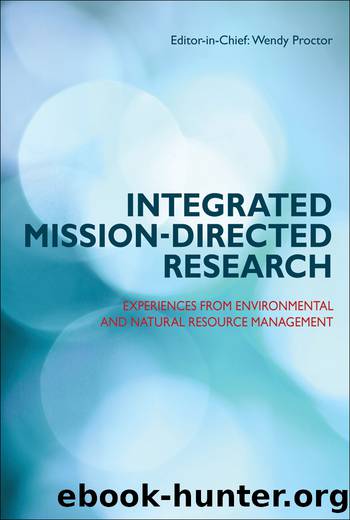Integrated Mission-Directed Research by Proctor Wendy;

Author:Proctor, Wendy;
Language: eng
Format: epub
Publisher: CSIRO Publishing
(1) nature of technology, which refers to peopleâs perceptions and understanding of the technology
(2) technology strategy, which refers to peopleâs views of why their organisation acquired and implemented the technology
(3) technology in use, which refers to peopleâs understanding of how the technology will be used and the likely or actual conditions and consequences associated with such use.
Analysis of these three dimensions of technological frames provides a useful platform for examining how people interpret the meaning and value of a particular technology, their views on whether it should be implemented and, if so, why it should be implemented and how it can be used to create a change in behaviour and practice.
The concept of technological frames is particularly concerned with examining whether people hold similar or different technological frames. Members of a particular social group will hold similar technological frames because they share common relationships and experiences (Sahay and Robey 1996). In the context of agricultural research, farmers and scientists hold different technological frames, reflecting their background and experiences. However, technological frames can also be different within social groups. For example, the soils and/or climatic condition on one farm may be different from others, shaping the technological frame of that farmer, while scientists from different disciplines may have different technological frames.
Orlikowski and Gash (1994, p. 180) refer to holding similar technological frames as congruence, which refers to âthe alignment of frames on key elements or categoriesâ. Congruence in technological frames occurs when members of social groups share similar expectations about the nature of the technology and the use that it serves. Incongruence in technological frames occurs when members of different social groups hold differing expectations or assumptions about some important aspects of the technology. For instance, developers and/or advanced users of a DSS may hold quite different convictions and expectations to practitioners about what that technology can deliver, because their interactions with the DSS differ, they come from different social positions or backgrounds and have different needs and interests (Sahay and Robey 1996). Orlikowski and Gash (1994) argue that incongruence in technological frames can create difficulties for the development and implementation of technology, because incongruence can lead to conflicts over the use and value of the technology, and so a key attribute in the participatory application of technologies is gaining increasingly congruent technological frames.
The inner circle in the framework focuses on the processes involved in the participatory application of DSS. The concept of a boundary object provides a novel perspective on the role of technology as an intermediary between scientists and practice communities in technology development. Star and Griesemer (1989) developed the concept of boundary objects in their study of the early years of the Museum of Vertebrate Zoology at the University of California, Berkeley. They define boundary objects as:
⦠objects which are plastic enough to adapt to local needs and constraints of the several parties employing them, yet robust enough to maintain a common identity across sites (Star and Griesemer 1989, p. 393).
Download
This site does not store any files on its server. We only index and link to content provided by other sites. Please contact the content providers to delete copyright contents if any and email us, we'll remove relevant links or contents immediately.
| Automotive | Engineering |
| Transportation |
Whiskies Galore by Ian Buxton(41524)
Introduction to Aircraft Design (Cambridge Aerospace Series) by John P. Fielding(32884)
Small Unmanned Fixed-wing Aircraft Design by Andrew J. Keane Andras Sobester James P. Scanlan & András Sóbester & James P. Scanlan(32569)
Craft Beer for the Homebrewer by Michael Agnew(17927)
Turbulence by E. J. Noyes(7690)
The Complete Stick Figure Physics Tutorials by Allen Sarah(7135)
Kaplan MCAT General Chemistry Review by Kaplan(6589)
The Thirst by Nesbo Jo(6432)
Bad Blood by John Carreyrou(6271)
Modelling of Convective Heat and Mass Transfer in Rotating Flows by Igor V. Shevchuk(6219)
Learning SQL by Alan Beaulieu(6029)
Weapons of Math Destruction by Cathy O'Neil(5823)
Man-made Catastrophes and Risk Information Concealment by Dmitry Chernov & Didier Sornette(5641)
Digital Minimalism by Cal Newport;(5388)
Life 3.0: Being Human in the Age of Artificial Intelligence by Tegmark Max(5182)
iGen by Jean M. Twenge(5156)
Secrets of Antigravity Propulsion: Tesla, UFOs, and Classified Aerospace Technology by Ph.D. Paul A. Laviolette(4974)
Design of Trajectory Optimization Approach for Space Maneuver Vehicle Skip Entry Problems by Runqi Chai & Al Savvaris & Antonios Tsourdos & Senchun Chai(4837)
Electronic Devices & Circuits by Jacob Millman & Christos C. Halkias(4739)
